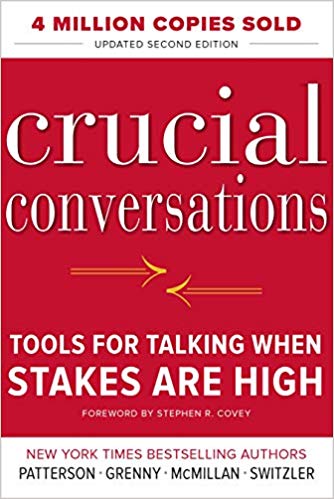

This article is an excerpt from the Shortform summary of "Crucial Conversations" by Kerry Patterson. Shortform has the world's best summaries of books you should be reading.
Like this article? Sign up for a free trial here .
What is mutual purpose? How can you achieve mutual purpose in crucial conversations?
Mutual purpose is the idea that two parties can come to a conversation with a common goal. Keep reading to find out how to achieve and maintain a mutual purpose in crucial conversations, and how it can help you communicate.
What Is Mutual Purpose?
We’ve all been part of conversations in which we didn’t feel safe to say what was on our mind. This chapter explains what to do to fix that. The basic steps in brief are:
- Step away from the content of the conversation.
- Determine whether mutual purpose or mutual respect is at risk.
- Restore safety by restoring mutual purpose or respect (Use skills: apologize, contrast, rebuild mutual purpose; or, if you don’t already have a mutual purpose, create one using CRIB: Commit, Respect, Invent, Brainstorm).
- Rejoin the conversation: Return to the issue at hand.
Steps for a Mutual Purpose
Here’s a look at each step in detail.
1. Step Away
The best approach when you don’t feel comfortable speaking your mind is to step away from the content of the conversation until you can enhance safety.
2. Is Respect at Risk?
The first step to building safety is understanding which of two requirements — mutual purpose or mutual respect — is at risk. Each requires a different solution.
Mutual Purpose: The Prerequisite for Dialogue
To have a successful crucial conversation, the participants must agree on a mutual purpose for having the conversation in the first place. Members believe everyone is working toward a common outcome and cares about others’ goals and interests.
Mutual purpose is the first requirement of dialogue. When you have a shared goal, everyone is motivated to participate, and there’s a positive atmosphere for talking.
Crucial conversations can go wrong when others don’t believe you’re contributing to a common goal, but instead have a hidden agenda (for instance, winning or punishing). Everything you say is suspect, even if you put it mildly. The problem isn’t the content of the conversation, it’s distrust of your motives. Signs that mutual purpose is in doubt include arguing, aggressiveness, and defensiveness.
To assess mutual purpose, ask yourself whether others believe you care about their goals and whether they trust your motives. In crucial conversations, you must genuinely care about the interests of others. If your goal is to get your way or manipulate, others will quickly realize it.
Mutual Respect: The Requirement for Continuing Dialogue
Starting a conversation based on mutual purpose is the first step to addressing a crucial issue. But the conversation can’t continue if you don’t maintain mutual respect (others’ views and feelings are treated as equally worthy of consideration).
If people start feeling disrespected, the dialogue stops. Respect is like air – while you have it nobody thinks about it, but when it’s gone, people can think about nothing else. The conversation shifts from its original purpose to one of defending dignity.
Besides your words, behaviors such as shaking your head, sighing, or rolling your eyes can convey disrespect and shut down a conversation. Emotions are the key indication that people are defending their dignity. To assess mutual respect, ask yourself whether others feel you respect them.
When It’s Hard to Respect Someone
It can be difficult to respect (or share a purpose) with people whose values and morals differ completely from yours, or with someone who is self-centered or has dubious motives.
But you don’t have to share every objective or respect every aspect of another person’s character before you can talk. Try this:
- Respect the other person as a human being.
- Focus on ways you’re similar rather than different.
- Without excusing others’ behavior, empathize. When you remember that everyone has weaknesses it’s easier to respect others.
When you do these things, you can feel a connection or mutuality and you can talk with the most difficult people.
3. Ensure Mutual Purpose and Respect
Once you step away from the content of a conversation, there are three skills you can use to restore either mutual purpose or mutual respect: apologize, contrast, create a mutual purpose.
Apologize If Warranted
When your behavior has made others doubt your respect or commitment to the shared purpose, offer a sincere apology. If you made a mistake that hurt others, express your regret. To be sincere, your motives have to change: You have to give up saving face, being right, or winning in order to focus on what you really want. When you sacrifice your ego, you’ll get something more important — productive dialogue.
If your apology has helped restore safety, you can then explain what happened, then return to the original issue. If it hasn’t, you’ll have to draw on other dialogue skills (more on that in a moment).
Use Contrasting to Repair Misunderstanding
Sometimes when you’re sharing your views in crucial conversations, others believe unjustifiably that you’re out to harm or coerce them. You shouldn’t apologize because you haven’t done anything wrong – this would be disingenuous. To rebuild mutual purpose/mutual respect when others misinterpret your purpose or intent, you can use the skill of contrasting.
Contrasting is a two-part don’t/do statement that assures others that you respect them and clarifies your purpose. You explain what you don’t want, followed by what you do want.
Contrasting works this way:
- “I don’t want to imply that I don’t value your work.” (What the manager doesn’t want)
- “I think your work has been outstanding and I want the leadership to understand the value of what you do.” (What he does want)
Of the two parts of contrasting, the don’t is more important because it deals with the misunderstanding that has undermined safety. You address the misunderstanding first, then explain what you intended.
In the Yvonne/Jotham conversation earlier, Yvonne could use contrasting when she returns to the conversation on intimacy: “I don’t want to put this all on you — it’s on both of us. What I do want is to be able to talk about it so we can improve things for both of us.”
Contrasting isn’t apologizing — it provides context and proportion. Sometimes when others take your words the wrong way, you’re tempted to water down what you’re trying to say. Don’t backpedal, but put your words in context: “Let me put this in perspective…I don’t mean to imply…”
You can use contrasting preemptively as well, to enhance safety when what you’re about to say could spark defensiveness: “I don’t want you to think I don’t appreciate…but”
Practical tip: When people take something the wrong way and you start arguing over the misunderstanding, stop and use contrasting. Explain what you don’t mean until it’s safe to return to the conversation.
4. Create a Mutual Purpose
Sometimes you end up in a debate because purposes differ. You could ignore the problem and push ahead, give up and let others have their way, or strike a messy compromise. However, the best approach is to back up and create a shared purpose by using four skills with the acronym CRIB: Commit, Recognize, Invent, Brainstorm.
C: Commit
Commit to seeking a mutual purpose. Commit to staying in conversation until the parties come up with a purpose everyone shares. Give up your belief that your choice is the best — there may be a different choice that suits everyone. Verbalize your commitment to finding a shared purpose, even if someone else seems committed to winning. Your commitment builds safety so others can feel more confident and participate.
R: Recognize
Recognize the purpose behind the strategy: When you’re asking for something and the other person is asking for something else, you’re focused on strategy rather than what you really want. Refocusing on what you really want can help create a mutual purpose.
For example, one person wants to stay at home and the other wants to go out. These are strategies to achieve something else (a purpose that each person has). The two purposes are: to spend time together away from the kids; and to have some peace and quiet rather than running around. Their mutual purpose could be: Find something to do that is quiet and away from kids. With a mutual purpose, it will be easier to agree on a strategy.
You can break an impasse by asking, “Why do you want to do that?” Before you can agree on a mutual purpose, you need to know what people’s real purposes are. Step away from the content of the conversation, which is typically focused on strategies, and explore the purposes behind them.
When you separate strategies from purpose, new options become possible. When you focus on your real purpose you’re open to the idea of finding alternative strategies to serve everyone’s interests.
I: Invent
Invent a mutual purpose: If your goals and interests are completely at odds, you have to invent a mutual purpose. You do this by moving to more encompassing goals. For example, you and your spouse may disagree on whether you should take a promotion that requires moving to a new city. But you can agree on a larger goal: the needs of your relationship and family come before career interests. By focusing on bigger, longer-term goals, you can find ways to transcend short-term compromises that no one likes.
B: Brainstorm
Brainstorm new strategies: After finding shared purpose, return to dialogue and brainstorm strategies that address everyone’s needs. You’ll no longer get bogged down in conflict because you’ve committed to finding something everyone can support. And you’re free to think outside the box.
Finding a mutual purpose can be difficult, and even harder to stick with when you’re having a difficult crucial conversation. But mutual purpose is one of the cornerstones of crucial conversations, and you can use what you learned to practice finding common ground with others.

———End of Preview———
Like what you just read? Read the rest of the world's best summary of Kerry Patterson's "Crucial Conversations" at Shortform .
Here's what you'll find in our full Crucial Conversations summary :
- How to approach an argument without getting mad
- The mistakes most people make when trying to listen to someone else
- How to come up with win-win solutions that make everyone happy






